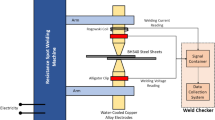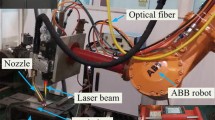Abstract
An integrated multi-objective optimization approach combining Kriging model and non-dominated sorting genetic algorithm-II (NSGA-II) is proposed to predict and optimize weld geometry in hybrid fiber laser-arc welding on 316L stainless steel in this paper. A four-factor, five-level experiment using Taguchi L25 orthogonal array is conducted considering laser power (P), welding current (I), distance between laser and arc (D) and traveling speed (V). Kriging models are adopted to approximate the relationship between process parameters and weld geometry, namely depth of penetration (DP), bead width (BW) and bead reinforcement (BR). NSGA-II is used for multi-objective optimization taking the constructed Kriging models as objective functions and generates a set of optimal solutions with pareto-optimal front for outputs. Meanwhile, the main effects and the first-order interactions between process parameters are analyzed. Microstructure is also discussed. Verification experiments demonstrate that the optimum values obtained by the proposed integrated Kriging model and NSGA-II approach are in good agreement with experimental results.













Similar content being viewed by others
References
N. Abe, M. Hayashi, Trends in laser arc combination welding methods. Weld. Int. 16, 94–98 (2002)
C. Bagger, F.O. Olsen, Review of laser hybrid welding. J. Laser Appl. 17, 2–14 (2005)
A. Mahrle, E. Beyer, Hybrid laser beam welding—classification, characteristics, and applications. J. Laser Appl. 18, 169–180 (2006)
B. Ribic, T.A. Palmer, T. DebRoy, Problems and issues in laser-arc hybrid welding. Int. Mater. Rev. 54, 223–244 (2009)
M. Baumeister, K. Dickmann, T. HoultFiber, laser micro-cutting of stainless steel sheets. Appl. Phys. A 85, 121–124 (2006)
L. Quintino, A. Costa, R. Miranda, D. Yapp, V. Kumar, C.J. Kong, Welding with high power fiber lasers—a preliminary study. Mater. Design 28, 1231–1237 (2007)
Y. Kawahito, T. Terajima, H. Kimura, T. Kuroda, K. Nakata, S. Katayama, A. Inoue, High-power fiber laser welding and its application to metallic glass Zr55Al10Ni5Cu30. Mater. Sci. Eng., B 148, 105–109 (2008)
D.X. Yang, X.Y. Li, D.Y. He, Z.R. Nie, H. Huang, Optimization of weld bead geometry in laser welding with filler wire process using Taguchi’s approach. Opt. Laser Technol. 44, 2020–2025 (2012)
Y. Javadi, S. Sadeghi, M.A. Najafabadi, Taguchi optimization and ultrasonic measurement of residual stresses in the friction stir welding. Mater. Design 55, 27–34 (2014)
C.W. Chan, H.C. Man, T.M. Yue, Parameter optimization for laser welding of NiTi wires by the Taguchi method. Laser. Eng. 30, 247–265 (2015)
C.N. Patel, P.S. Chaudhary, Parametric optimization of weld strength of metal inert gas welding and tungsten inert gas welding by using analysis of variance and grey relational analysis. Int. J. Res. Mod. Eng. Emerg. Tech. 1, 48–56 (2013)
S. Vijayan, R. Raju, S.R.K. Rao, Multiobjective optimization of friction stir welding process parameters on aluminum alloy AA 5083 using Taguchi-based grey relation analysis. Mater. Manuf. Process 25, 1206–1212 (2010)
H.R. Kim, K.Y. Lee, Using the orthogonal array with grey relational analysis to optimize the laser hybrid welding of a 6061-T6 Al alloy sheet. Proceedings of the Institution of Mechanical Engineers, Part B: J. Eng. Manuf. 222, 981-987 (2008)
M.M.A. Khan, L. Romoli, M. Fiaschi, G. Dini, F. Sarri, Multiresponse optimization of laser welding of stainless steels in a constrained fillet joint configuration using RSM. Int. J. Adv. Manuf. Tech. 62, 587–603 (2012)
A.K. Lakshminarayanan, V. Balasubramanian, Comparison of RSM with ANN in predicting tensile strength of friction stir welded AA7039 aluminium alloy joints. T. Nonferr. Metal. Soc. 19, 9–18 (2009)
K.Y. Benyounis, A.G. Olabi, M.S.J. Hashmi, Multi-response optimization of CO2 laser-welding process of austenitic stainless steel. Opt. Laser Technol. 40, 76–87 (2008)
A. Singh, S. Datta, S.S. Mahapatra, T. Singha, G. Majumdar, Optimization of bead geometry of submerged arc weld using fuzzy based desirability function approach. J. Intell. Manuf. 24, 35–44 (2013)
M. Moradi, M. Ghoreishi, J. Frostevarg, A.F.H. Kaplan, An investigation on stability of laser hybrid arc welding. Opt. Laser Eng. 51, 481–487 (2013)
K. Salonitis, P. Stavropoulos, A. Fysikopoulos, G. Chryssolouris, CO2 laser butt-welding of steel sandwich sheet composites. Int. J. Adv. Manuf. Tech. 69, 245–256 (2013)
S. Ghosal, S. Chaki, Estimation and optimization of depth of penetration in hybrid CO2 Laser-MIG welding using ANN-optimization hybrid model. Int. J. Adv. Manuf. Tech. 47, 1149–1157 (2009)
P. Sathiya, K. Panneerselvam, R. Soundararajan, Optimal design for laser beam butt welding process parameter using artificial neural networks and genetic algorithm for super austenitic stainless steel. Opt. Laser Technol. 44, 1905–1914 (2012)
D. Katherasan, J.V. Elias, P. Sathiya, A.N. Haq, Simulation and parameter optimization of flux cored arc welding using artificial neural network and particle swarm optimization algorithm. J. Intell. Manuf. 25(1), 67–76 (2014)
O.E. Canyurt, H.R. Kim, K.Y. Lee, Estimation of laser hybrid welded joint strength by using genetic algorithm approach. Mech. Mater. 40, 825–831 (2008)
Q. Zhou, P. Jiang, X.Y. Shao, Z.M. Gao, L.C. Cao, C. Yue, X.B. Li, Optimization of process parameters of hybrid laser–arc welding onto 316L using ensemble of metamodels. Metall. Mater. Trans. B (2016). doi:10.1007/s11663-016-0664-3
P. Jiang, L.C. Cao, Q. Zhou, Z.M. Gao, Y.M. Rong, X.Y. Shao, Optimization of welding process parameters by combining Kriging surrogate with particle swarm optimization algorithm. Int. J. Adv. Manuf. Tech. (2016). doi:10.1007/s00170-016-8382-1
S. Chaki, B. Shanmugarajan, S. Ghosal, G. Padmanabham, Application of integrated soft computing techniques for optimisation of hybrid CO2 laser-MIG welding process. Appl. Soft Comput. 30, 365–374 (2015)
N.K. Lim, Optimization of TIG weld geometry using a Kriging surrogate model and Latin hypercube sampling for data generation. (Department of Mechanical and Aerospace Engineering, California State University, Long Beach, USA, 2014)
J.G. Fang, Y.K. Gao, G.Y. Sun, C.M. Xu, Y.T. Zhang, Q. Li, Optimization of spot-welded joints combined artificial bee colony algorithm with sequential kriging optimization. Adv. Mech. Eng. 6, 1–10 (2014)
I. Andonegui, I. Calvo, A.J. Garcia-Adeva, Inverse design and topology optimization of novel photonic crystal broadband passive devices for photonic integrated circuits. Appl. Phys. A 115, 433–438 (2014)
W.Y. Ming, Z. Zhang, G.J. Zhang, Y. Huang, J.W. Guo, Y. Chen, Multi-objective optimization of 3D-surface topography of machining YG15 in WEDM. Mater. Manuf. Process 29, 514–525 (2014)
S. Chaki, R.N. Bathe, S. Ghosal, G. Padmanabham, Multi-objective optimisation of pulsed Nd:YAG laser cutting process using integrated ANN-NSGAII model. J. Intell. Manuf. (2015). doi:10.1007/s10845-015-1100-2
J.D. Poirier, S.S. Vel, V. Caccese, Multi-objective optimization of laser-welded steel sandwich panels for static loads using a genetic algorithm. Eng. Struct. 49, 508–524 (2013)
K. Siva-Prasad, C.S. Rao, D.N. Rao, Multi objective optimization of weld bead geometry parameters of pulsed current micro plasma arc welded inconel 625 using enhanced non-dominated sorting genetic algorithm. J Mater Metall Eng 3, 17–24 (2013)
Acknowledgments
This research has been supported by the National Basic Research Program (973 Program) of China under Grant No. 2014CB046703, the National Natural Science Foundation of China (NSFC) under Grant Nos. 51323009 and 51121002, and the Fundamental Research Funds for the Central Universities, HUST: Grant No. 2014TS040. The authors also would like to thank the anonymous referees for their valuable comments.
Author information
Authors and Affiliations
Corresponding author
Rights and permissions
About this article
Cite this article
Gao, Z., Shao, X., Jiang, P. et al. Multi-objective optimization of weld geometry in hybrid fiber laser-arc butt welding using Kriging model and NSGA-II. Appl. Phys. A 122, 610 (2016). https://doi.org/10.1007/s00339-016-0144-2
Received:
Accepted:
Published:
DOI: https://doi.org/10.1007/s00339-016-0144-2




